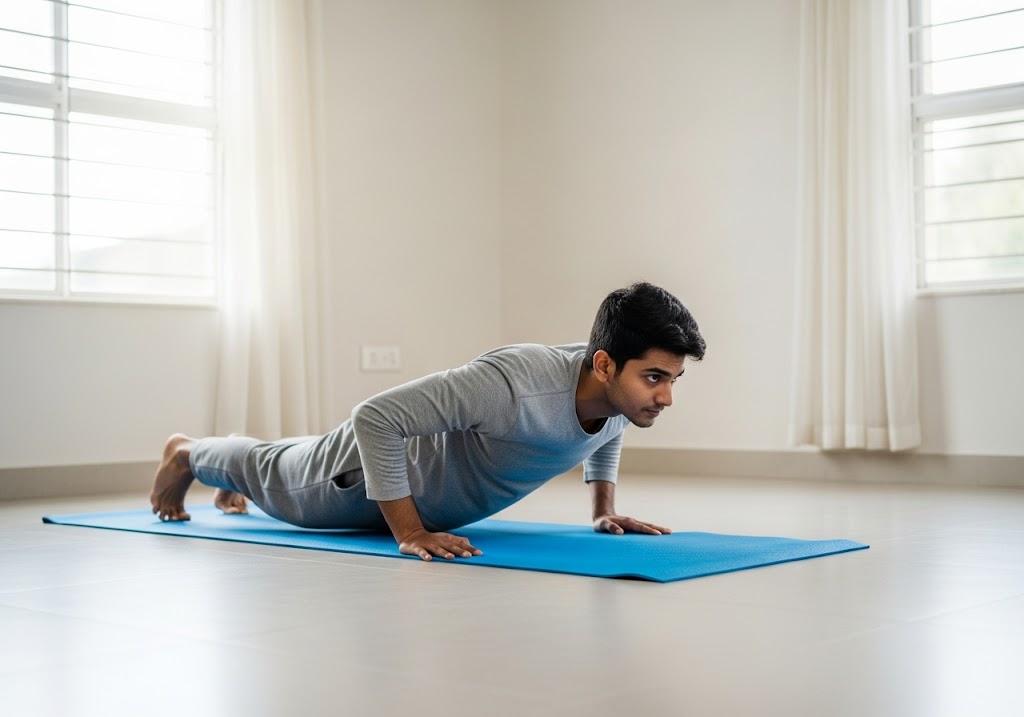How to do flutter kicks involves lying on your back and rapidly moving your straight legs up and down in an alternating pattern while keeping your core engaged.
Learning how to do flutter kicks properly can transform your core workout routine and build incredible lower abdominal strength. This simple yet effective exercise targets multiple muscle groups while improving your overall fitness level. Many people struggle with proper technique, leading to back pain or reduced effectiveness.
Flutter kicks offer an excellent way to strengthen your core without requiring any equipment. You can perform this exercise anywhere – at home, in the gym, or even outdoors. The movement mimics swimming motions, making it familiar for many people. When you understand how to do flutter kicks correctly, they engage your lower abs, hip flexors, and stabilizing muscles throughout your core.
Understanding the proper form is crucial for getting maximum benefits while avoiding injury. This exercise can be challenging for beginners, but with the right technique, anyone can master how to do flutter kicks effectively. We’ll cover everything you need to know about performing flutter kicks safely and effectively, including modifications for different fitness levels.
Table of Contents
What Are Flutter Kicks?
Flutter kicks are a popular bodyweight exercise that specifically targets your core muscles through rapid leg movements. Understanding how to do flutter kicks starts with knowing exactly what this exercise involves and why it’s so effective for building core strength.
| Aspect | Description |
|---|---|
| Exercise Type | Bodyweight cardio and strength exercise |
| Primary Target | Lower abdominal muscles |
| Secondary Muscles | Hip flexors, quads, glutes |
| Equipment Needed | None (just a mat) |
| Difficulty Level | Beginner to intermediate |
| Duration | 30-60 seconds per set |
| Position | Lying on back |
| Movement Pattern | Alternating leg lifts |
Flutter kicks are performed by lying flat on your back and moving your legs in a rapid, alternating up-and-down motion. The exercise gets its name from the fluttering movement that resembles a swimmer’s kick. This motion primarily works your lower rectus abdominis, which is the bottom portion of your six-pack muscles.
The exercise also engages your hip flexors significantly, as these muscles help lift your legs against gravity. Your quadriceps and glutes work as stabilizers throughout the movement. The constant tension required to keep your legs elevated makes how to do flutter kicks an excellent core strengthening exercise that also provides cardiovascular benefits.
Learn more about how to do plank exercise to complement your core training routine.
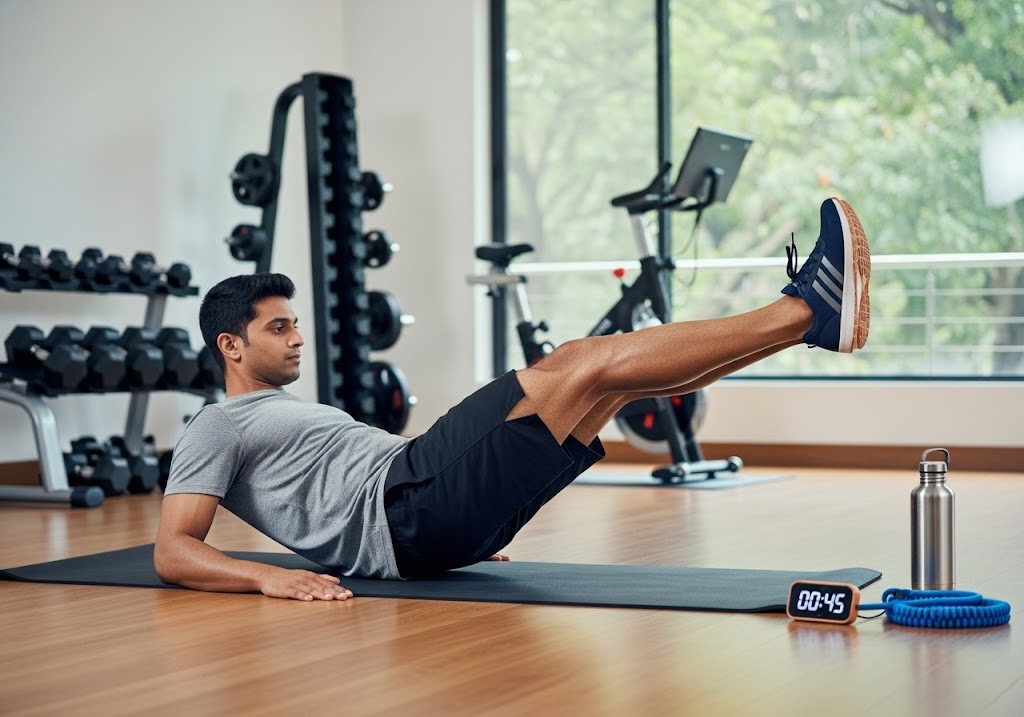
How to Do Flutter Kicks? : A Step-by-Step Method
Mastering the proper technique for how to do flutter kicks requires attention to detail and consistent practice. Breaking down the movement into specific steps ensures you develop correct form from the beginning, preventing bad habits and maximizing results for your core development goals.
| Step | Action | Duration | Key Focus |
|---|---|---|---|
| 1 | Setup Position | 10 seconds | Proper alignment and stability |
| 2 | Core Activation | 5 seconds | Engage deep abdominal muscles |
| 3 | Leg Positioning | 5 seconds | Optimal angle and height |
| 4 | Movement Initiation | 2-3 seconds | Controlled start of flutter pattern |
| 5 | Maintain Rhythm | 20-60 seconds | Consistent alternating motion |
| 6 | Proper Breathing | Throughout | Steady oxygen flow |
| 7 | Safe Completion | 5 seconds | Controlled leg lowering |
Learn about how to burn 300 calories a day to complement your fitness goals.
Step 1: Setup Position
Proper setup is crucial for learning how to do flutter kicks safely and effectively. Begin by lying on a comfortable exercise mat with your entire back making contact with the surface. Position your arms straight by your sides with palms flat against the ground for stability.
- To Do: Place head in neutral position, shoulders relaxed, legs together and straight
- Posture: Maintain natural spine curve, avoid neck tension
- Timing: Take 10 seconds to establish perfect position
- Tips: Use a thick mat for comfort, ensure flat surface, check body alignment before starting movement
For home training, learn about calisthenics equipment for home to enhance your workout environment and exercise options.
Step 2: Core Activation
Core engagement is essential before beginning any leg movements in how to do flutter kicks. Press your lower back gently into the floor while drawing your belly button toward your spine. This creates the stable foundation needed for safe execution.
- To Do: Tighten deep abdominal muscles, maintain lower back contact with floor
- Posture: Keep ribcage down, avoid arching back
- Timing: Hold activation for 5 seconds before leg movement
- Tips: Practice hollow body hold separately, breathe normally while engaging core, focus on quality over intensity
Discover resistance band exercises for abs for additional core strengthening options.
Step 3: Leg Positioning
Correct leg positioning determines the effectiveness of how to do flutter kicks while protecting your spine. Lift both legs simultaneously to create a 30-45 degree angle with the floor, keeping knees completely straight throughout the setup phase.
- To Do: Raise legs together, maintain straight knees, point toes slightly
- Posture: Keep hips level, legs parallel to each other
- Timing: Take 5 seconds for smooth leg elevation
- Tips: Start higher if you’re a beginner, lower legs as strength improves, avoid sudden movements
Step 4: Movement Initiation
Beginning the flutter motion requires coordination and control when learning how to do flutter kicks. Start with small, alternating movements where one leg rises slightly while the other lowers, creating the characteristic fluttering pattern of this exercise.
- To Do: Begin tiny alternating motions, keep movements controlled and small
- Posture: Maintain core engagement, prevent back arch
- Timing: Use 2-3 seconds for initial movement pattern
- Tips: Start slowly to establish rhythm, focus on form over speed, keep range of motion minimal initially
Understanding does calisthenics increase height helps set realistic expectations for your training outcomes.
Step 5: Maintain Rhythm
Sustaining consistent movement is key to maximizing benefits when you understand how to do flutter kicks properly. Continue the alternating leg pattern while maintaining constant core engagement and proper breathing throughout the entire exercise duration.
- To Do: Keep steady alternating pattern, maintain consistent speed and range
- Posture: Preserve spine alignment, avoid letting back lift off floor
- Timing: Continue for 20-60 seconds depending on fitness level
- Tips: Count flutter kicks to maintain focus, stop if form breaks down, gradually increase duration over time
Step 6: Proper Breathing
Maintaining steady breathing enhances performance and safety while learning how to do flutter kicks. Breathe naturally throughout the exercise, avoiding breath-holding that can cause dizziness and reduce core stability during the movement.
- To Do: Breathe continuously, exhale with effort, inhale during easier phases
- Posture: Keep shoulders relaxed, avoid chest breathing
- Timing: Coordinate breath with movement rhythm throughout exercise
- Tips: Practice breathing pattern separately first, focus on diaphragmatic breathing, never hold your breath during exercise
Check out how to do jumping jacks to add cardio variety to your routine.
Step 7: Safe Completion
Properly ending your set is as important as the exercise itself when mastering how to do flutter kicks. Lower your legs slowly and under control, maintaining core engagement until your feet touch the ground to prevent sudden back stress.
- To Do: Lower legs gradually, maintain core tension, rest in starting position
- Posture: Keep back flat during leg lowering, avoid sudden relaxation
- Timing: Take 5 seconds for controlled descent
- Tips: Don’t drop legs suddenly, breathe deeply after completion, assess how you feel before next set
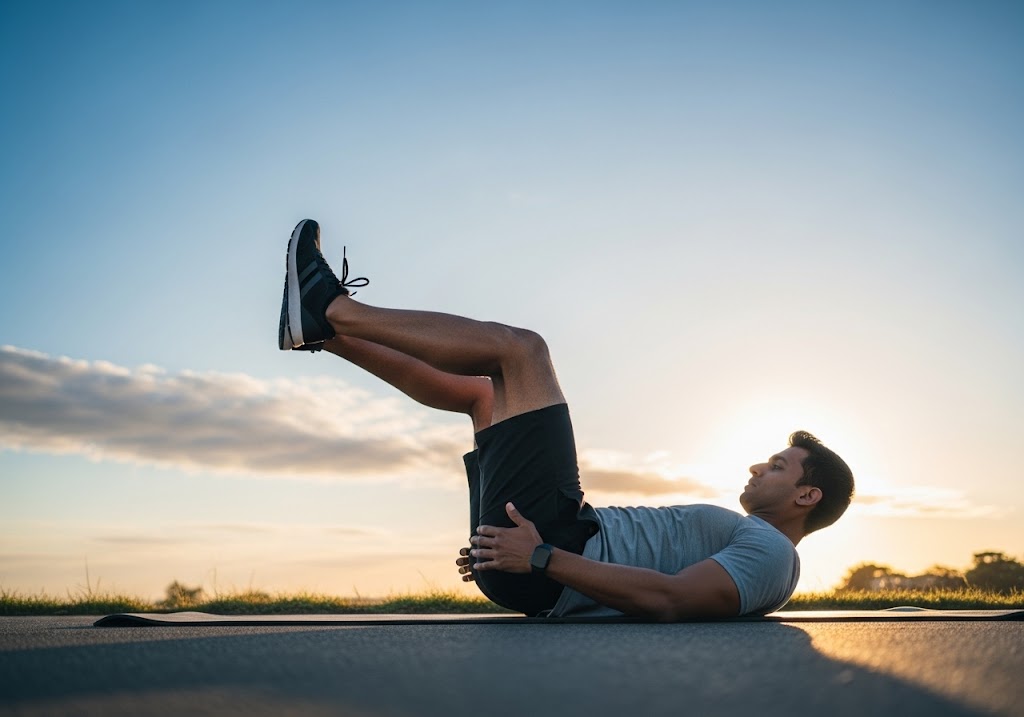
How to Do Flutter Kicks Without Arching Back?
Learning how to do flutter kicks without arching back is crucial for preventing injury and maximizing the exercise’s effectiveness. Back arching occurs when your core muscles aren’t properly engaged, causing your lower back to lift off the ground. This position shifts the workload away from your abs and places unnecessary stress on your spine.
The key to avoiding back arch lies in maintaining constant core engagement throughout the entire movement. Before lifting your legs, press your lower back firmly into the ground and imagine pulling your belly button toward your spine. This creates a stable foundation that prevents your back from lifting. Keep your legs at a higher angle initially – around 45 degrees – until your core strength improves enough to lower them safely.
Important Pointers for Preventing Back Arch:
- Pre-tension Your Core – Engage your abs before lifting legs and maintain this tension throughout the entire exercise
- Press Lower Back Down – Actively push your lower back into the floor and keep it there during all movements
- Start with Higher Leg Position – Keep legs at 45-degree angle initially, lowering gradually as strength improves
- Use Smaller Range of Motion – Perform tiny flutter movements rather than large leg swings that destabilize position
- Place Hands for Support – Position hands under lower back or glutes to provide additional stability if needed
- Monitor Your Position – Stop immediately if you feel your back lifting and reset your position
- Strengthen Core First – Build basic core strength with easier exercises before attempting flutter kicks
- Focus on Quality Over Quantity – Maintain perfect form rather than counting repetitions or extending duration
Focus on smaller leg movements rather than large, sweeping motions that can destabilize your position. Your hip flexors should do most of the work while your abs provide stability. If you feel your back starting to arch, immediately raise your legs higher or take a brief rest to reset your position.
Explore how to do glute bridge exercises to strengthen your posterior chain and support better form.
Core Engagement Tips
Proper core activation is essential for understanding how to do flutter kicks without compromising your spine alignment. Your deep abdominal muscles must work continuously to maintain the correct position throughout the exercise.
Practice the “hollow body” position by lying on your back and pressing your lower back into the floor while slightly lifting your shoulders. This creates the ideal spinal position for flutter kicks. Maintain this core bracing throughout the entire exercise, breathing steadily without allowing your abs to relax.
How to Do Flutter Kicks Without Hurting Back?
Understanding how to do flutter kicks without hurting back requires proper preparation, correct form, and awareness of your body’s limitations. Back pain during flutter kicks usually results from poor technique or attempting the exercise before building adequate core strength.
Several strategies can help you perform flutter kicks safely while protecting your lower back:
- Start with Modified Versions – Begin with bent knees or single-leg variations to build strength gradually
- Use Proper Hand Placement – Place hands under your lower back or glutes for additional support during the movement
- Maintain Higher Leg Position – Keep legs elevated higher until your core strength improves significantly
- Focus on Small Movements – Perform tiny flutter motions rather than large leg swings that stress your spine
- Stop if Pain Occurs – Immediately discontinue the exercise if you experience any back discomfort
- Strengthen Supporting Muscles – Build up your core strength with easier exercises before progressing to flutter kicks
- Warm Up Properly – Always prepare your muscles with gentle stretches and activation exercises
- Listen to Your Body – Progress slowly and don’t push through pain or extreme fatigue
Learning how to do flutter kicks correctly protects your spine while building core strength effectively.
Build upper body strength with calisthenics for triceps exercises to balance your training routine.
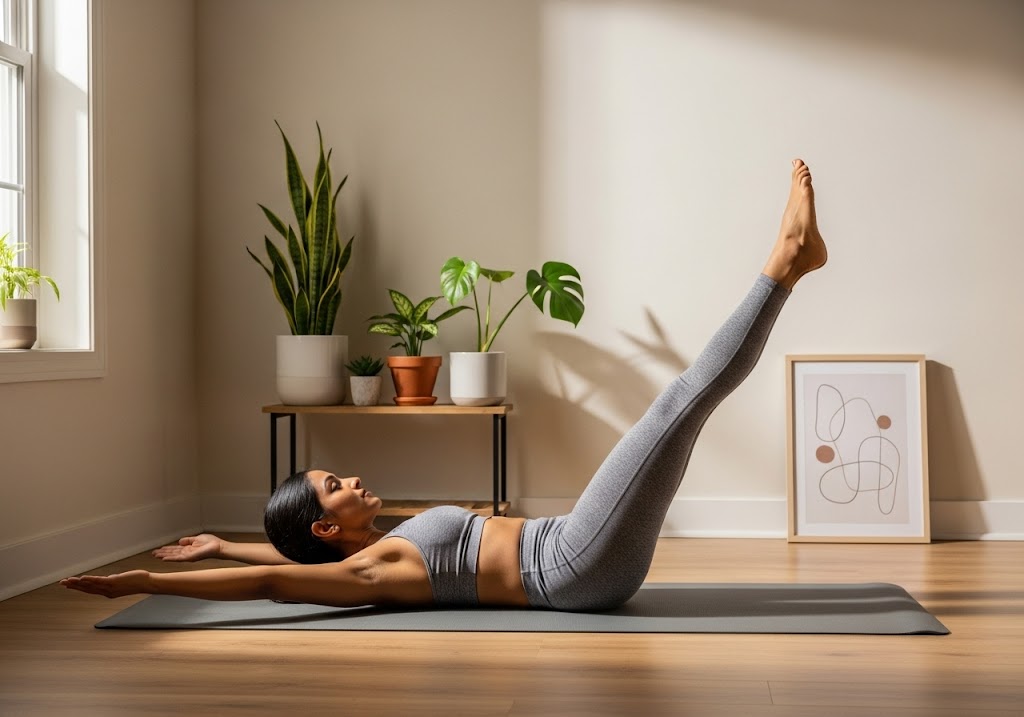
Benefits of Flutter Kicks
Understanding how to do flutter kicks opens the door to numerous fitness benefits that extend far beyond simple core strengthening. This exercise provides both immediate and long-term advantages for your physical fitness, cardiovascular health, and overall functional movement patterns.
Learning how to do flutter kicks correctly delivers multiple benefits for your body:
- Lower Abdominal Strengthening – Targets the hard-to-reach lower abs more effectively than traditional crunches or sit-ups
- Hip Flexor Development – Strengthens hip flexor muscles that are essential for walking, running, and daily movement patterns
- Cardiovascular Improvement – Rapid leg movements increase heart rate, providing excellent cardio benefits during strength training
- Core Stability Enhancement – Improves overall core stability that supports better posture and spinal health
- Muscle Endurance Building – Develops muscular endurance in your core and lower body through sustained contractions
- Calorie Burning – Burns significant calories in short time periods, making it efficient for weight management goals
- Functional Movement – Improves coordination and movement patterns used in sports and daily activities
- Posture Improvement – Strengthens muscles that support proper spine alignment and reduce slouching habits
- No Equipment Required – Can be performed anywhere without needing gym equipment or special facilities
- Time Efficient – Delivers maximum results in minimal time, perfect for busy schedules and quick workouts
- Versatile Exercise – Easily modified for different fitness levels and can be incorporated into various workout routines
- Lower Back Support – When performed correctly, can help reduce lower back pain by strengthening supporting muscles
Regular practice of how to do flutter kicks can significantly improve your overall fitness and core strength.
Jumping Jacks Exercise Benefits complement flutter kicks perfectly for a complete cardio and core routine.
Flutter Kick: Common Mistakes to Avoid
Many people make similar errors when learning how to do flutter kicks, which can reduce effectiveness and increase injury risk. Recognizing these common mistakes helps you maintain proper form and get better results while protecting yourself from potential harm.
Avoiding these common errors will help you master how to do flutter kicks safely and effectively:
- Lower Back Arching – Allowing your back to lift off the ground reduces core engagement and places harmful stress on your spine
- Legs Positioned Too Low – Starting with legs too close to the ground makes it impossible to maintain proper form throughout the exercise
- Large, Uncontrolled Movements – Using excessive range of motion destabilizes your position and reduces muscle activation
- Holding Your Breath – Breath-holding limits performance, causes dizziness, and reduces core stability during the movement
- Moving Too Fast – Rushing through movements sacrifices form and reduces the time your muscles spend under tension
- Tensing Neck and Shoulders – Lifting your head or tensing upper body creates unnecessary strain away from target muscles
- Poor Starting Position – Beginning on unstable surfaces or with incorrect hand placement compromises your entire exercise
- Ignoring Pain Signals – Continuing despite back pain or discomfort increases injury risk and prevents proper muscle development
- Starting Too Advanced – Attempting long durations or difficult variations before mastering basic form leads to technique breakdown
- Inconsistent Core Engagement – Allowing abs to relax during the exercise shifts work to hip flexors and stresses the spine
- Wrong Leg Position – Keeping legs too wide apart or allowing knees to bend reduces exercise effectiveness
- No Progressive Approach – Jumping to advanced versions without building foundational strength increases injury risk significantly
Mastering proper technique for how to do flutter kicks requires patience and consistent practice.
Discover how to burn 400 calories a day with effective exercise combinations.
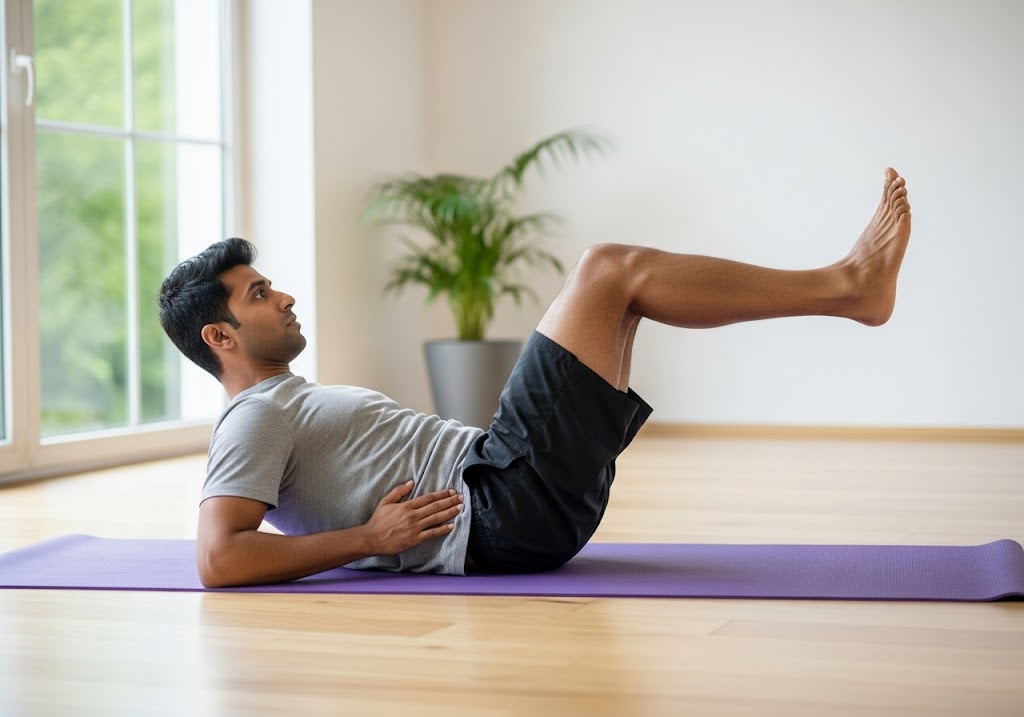
Flutter Kick Variations
Once you master the basic technique of how to do flutter kicks, several variations can add challenge and target different muscle groups. These modifications help prevent boredom, continue progressing your fitness level, and address specific training goals or physical limitations.
| Variation | Difficulty Level | Primary Focus | Equipment Needed |
|---|---|---|---|
| Reverse Flutter Kicks | Intermediate | Glutes, Hamstrings | Mat |
| Criss-Cross Flutter | Beginner-Intermediate | Lower Abs, Obliques | Mat |
| Bicycle Kicks | Intermediate | Full Core, Obliques | Mat |
| Scissor Kicks | Beginner | Lower Abs, Hip Flexors | Mat |
| Single-Leg Flutter | Beginner | Unilateral Strength | Mat |
| Weighted Flutter | Advanced | Lower Abs, Hip Flexors | Ankle Weights |
| Hollow Body Flutter | Advanced | Full Core Integration | Mat |
1. Reverse Flutter Kicks
Reverse flutter kicks are performed lying face-down, targeting your glutes and hamstrings more intensively than the traditional version. This variation helps balance your posterior chain strength while still engaging your core muscles for stability and control.
- To Do: Lie face-down, lift legs alternately behind you, keep movements small and controlled
- Posture: Maintain neutral neck, engage glutes and core, avoid excessive back arch
- Timing: Start with 20-30 seconds, progress to 45-60 seconds
- Tips: Use pillow under hips for comfort, focus on glute activation, keep movements within pain-free range
Understanding how to do flutter kicks in reverse position adds variety to your posterior chain training.
2. Criss-Cross Flutter Kicks
Criss-cross flutter involves moving your legs horizontally while maintaining the vertical fluttering motion, adding a coordination challenge. This variation engages your obliques more intensively while maintaining the lower abdominal focus of traditional flutter kicks.
- To Do: Alternate legs vertically while crossing them horizontally, maintain steady rhythm
- Posture: Keep lower back pressed down, core engaged throughout movement
- Timing: Perform for 30-45 seconds initially, building to 60 seconds
- Tips: Start with smaller crossing movements, focus on control over speed, breathe continuously throughout exercise
Combine with arm workouts with dumbbells women’s for complete upper and lower body training.
3. Bicycle Kicks
Bicycle kicks combine flutter kicks with a pedaling motion that engages your obliques and adds a rotational component. This variation provides excellent full-core activation while improving coordination and functional movement patterns for daily activities.
- To Do: Alternate bringing knees toward chest while extending opposite leg, simulate pedaling motion
- Posture: Keep shoulders slightly lifted, maintain core tension, avoid pulling on neck
- Timing: Complete 20-30 pedaling motions per set initially
- Tips: Focus on touching elbow to opposite knee, maintain controlled breathing, keep movements deliberate and precise
Learning how to do flutter kicks with bicycle motion challenges your coordination significantly.
Learn proper recovery techniques with how to lift heavier weights for progressive strength development.
4. Scissor Kicks
Scissor kicks use a wider range of motion with legs crossing over each other in a horizontal plane. This variation emphasizes hip flexor strength while maintaining core stability, making it excellent for improving functional movement patterns.
- To Do: Keep legs straight, cross one over the other horizontally, alternate crossing pattern
- Posture: Maintain flat back position, engage core continuously, keep head relaxed
- Timing: Start with 30 seconds, progress to 60 seconds as strength improves
- Tips: Control the crossing motion, avoid letting legs drop too low, maintain steady breathing pattern throughout
5. Single-Leg Flutter Kicks
Single-leg flutter kicks allow you to focus on one side at a time for addressing muscle imbalances. This unilateral variation helps identify and correct strength differences between sides while providing a less intense introduction to flutter kicks.
- To Do: Perform flutter motion with one leg while keeping other leg stable, switch sides
- Posture: Maintain core engagement, keep stable leg position consistent
- Timing: Complete 15-20 seconds per leg, alternating between sides
- Tips: Focus on quality over quantity, rest between leg switches if needed, progress to longer durations gradually
Mastering how to do flutter kicks with single-leg focus improves bilateral strength balance.
Balance your core training with chest and tricep workout with dumbbells for complete upper body development.
6. Weighted Flutter Kicks
Weighted flutter kicks add ankle weights for increased resistance once you’ve mastered the basic movement. This advanced variation significantly increases the challenge for your hip flexors and core muscles, promoting continued strength development.
- To Do: Add light ankle weights, perform standard flutter kick motion with increased resistance
- Posture: Maintain perfect form despite added weight, engage core extra firmly
- Timing: Reduce duration initially to 15-30 seconds with weights
- Tips: Start with very light weights (0.5-1 kg), focus on maintaining form, remove weights if form breaks down
Explore how to do arnold press for complementary upper body strength training.
7. Hollow Body Flutter Kicks
Advanced practitioners can try hollow body flutter kicks, where you lift your shoulders off the ground while performing the leg movements. This variation significantly increases the challenge for your entire core and requires excellent strength and coordination.
- To Do: Lift shoulders off ground, extend arms overhead or by ears, perform flutter kicks
- Posture: Create hollow body position, maintain constant core tension, avoid neck strain
- Timing: Start with 15-20 seconds, building very gradually
- Tips: Master hollow body hold first, keep lower back pressed down, breathe steadily despite increased difficulty
Progressive mastery of how to do flutter kicks variations builds complete core strength and prevents workout plateaus.
Discover calisthenics vs weightlifting to understand different training approaches.
Flutter Kick: Safety Tips and Precautions
Safety should always be your primary concern when learning how to do flutter kicks. Following proper precautions ensures you can enjoy the benefits while minimizing injury risk and building long-term fitness success through consistent, safe practice.
Follow these essential safety guidelines when learning how to do flutter kicks:
- Always Warm Up First – Complete 5-10 minutes of light cardio and dynamic stretches before attempting flutter kicks
- Start with Shorter Durations – Begin with 15-20 seconds per set and gradually increase time as your strength improves
- Listen to Your Body – Stop immediately if you experience any pain, dizziness, or unusual discomfort during exercise
- Use Proper Surface – Always use a quality exercise mat on a flat, stable surface to prevent slipping or discomfort
- Maintain Proper Form – Prioritize correct technique over duration or speed, especially when fatigue begins to set in
- Stay Hydrated – Drink water before, during, and after your workout to maintain optimal performance and safety
- Avoid After Large Meals – Wait at least 2-3 hours after eating before performing flutter kicks to prevent digestive issues
- Get Medical Clearance – Consult healthcare providers if you have back problems, hip injuries, or other health concerns
- Progress Gradually – Increase intensity, duration, or difficulty slowly over time to prevent overuse injuries
- Ensure Adequate Space – Clear area around you of obstacles to move safely without restrictions or hazards
- Breathe Continuously – Never hold your breath during the exercise as this can cause dizziness and reduce performance
- Stop When Form Breaks Down – End the set immediately when you can no longer maintain proper technique
- Cool Down Properly – Include gentle stretches for hip flexors, abs, and lower back after completing flutter kicks
- Build Supporting Strength – Develop overall core strength with other exercises to support flutter kick performance safely
Understanding how to do flutter kicks safely prevents injuries and ensures consistent progress toward your fitness goals.
Learn about what is foam rolling for recovery and injury prevention.
Creating an Effective Flutter Kick Routine
Building an effective routine around how to do flutter kicks requires proper programming and progression strategies. Start with basic versions and gradually advance to more challenging variations as your strength improves. Consistency and progressive overload are essential for achieving optimal results.
| Fitness Level | Frequency | Sets | Duration | Rest Between Sets | Weekly Progression |
|---|---|---|---|---|---|
| Beginner | 2-3 times/week | 2-3 sets | 15-30 seconds | 30-60 seconds | Add 5 seconds weekly |
| Intermediate | 3-4 times/week | 3-4 sets | 30-60 seconds | 45-60 seconds | Add 10 seconds weekly |
| Advanced | 4-5 times/week | 4-5 sets | 45-90 seconds | 60-90 seconds | Add variations/weights |
| Circuit Training | 3-4 times/week | Include in circuits | 30-45 seconds | Minimal (10-15 sec) | Increase intensity |
| HIIT Integration | 2-3 times/week | Part of intervals | 20-40 seconds | Work/rest ratios | Vary timing patterns |
Consider incorporating flutter kicks into your existing workout schedule with adequate recovery time between sessions for optimal muscle adaptation and growth. Combine flutter kicks with other core exercises and full-body movements for balanced training approach.
Explore can hiit build muscle to understand how high-intensity training supports muscle development.
Advanced practitioners who have mastered how to do flutter kicks can explore integrating them into circuit training or HIIT workouts. The cardiovascular benefits make them excellent for fat-burning routines when combined with other dynamic exercises.
Strengthen your entire body with bodybuilding exercises at home to complement your flutter kick training. Explore different training approaches with hack squat vs leg press to diversify your lower body training.
Conclusion
Mastering how to do flutter kicks provides an excellent foundation for core strength development and overall fitness improvement. This versatile exercise requires no equipment while delivering impressive results for your abdominal muscles, hip flexors, and cardiovascular system. Remember to prioritize proper form over speed or duration, especially when starting your flutter kick journey.
Want to master the calisthenics handstand and take your skills to the next level? Whether you’re a beginner or pushing advanced skills, ISC – Indian School of Calisthenics offers expert guidance to help you master bodyweight training. Visit us at SRPF Ground, NH8, Goregaon (E), Mumbai – 400065. For class schedules, personalized coaching, or more details, call +91 77159 53218. Train smart, move better, and unlock your back strength with ISC.
How to Do Flutter Kicks? – FAQs
How do you properly perform flutter kicks?
Learning how to do flutter kicks involves lying on your back with legs straight, lifting them 6-12 inches off the ground, and alternating rapid up-and-down movements while keeping your core engaged.
How long should I do flutter kicks as a beginner?
When starting how to do flutter kicks, begin with 20-30 seconds per set and gradually increase duration as your core strength and endurance improve over time.
Why does my back hurt when I do flutter kicks?
Back pain occurs when your lower back arches off the ground due to weak core muscles or legs positioned too low during how to do flutter kicks execution.
How many flutter kicks should I do per workout?
For proper how to do flutter kicks training, aim for 2-3 sets of 30-60 seconds each, or count 20-30 kicks per leg depending on your fitness level.
Can flutter kicks help reduce belly fat?
Understanding how to do flutter kicks helps strengthen core muscles and burn calories, but spot reduction isn’t possible – combine with proper diet and cardio for fat loss.
What muscles do flutter kicks primarily target?
When you learn how to do flutter kicks, you mainly work your lower rectus abdominis (lower abs), hip flexors, and secondarily engage your quads and glutes for stabilization.
Are flutter kicks suitable for beginners?
Yes, beginners can start learning how to do flutter kicks with modified versions like bent-knee flutter kicks or shorter durations until they build adequate core strength.
How often should I include flutter kicks in my routine?
Perform how to do flutter kicks 2-3 times per week with rest days between sessions to allow proper muscle recovery and strength development.
What’s the difference between flutter kicks and scissor kicks?
The difference in how to do flutter kicks versus scissor kicks is that flutter kicks involve vertical leg movements while scissor kicks use horizontal crossing motions, targeting slightly different muscle patterns.
Can I do flutter kicks if I have lower back problems?
Consult your healthcare provider first before learning how to do flutter kicks, and if cleared, start with modified versions using higher leg positions and shorter durations.

